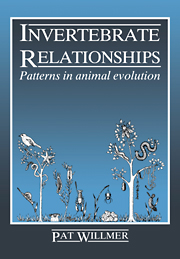Book contents
- Frontmatter
- Contents
- Acknowledgements
- Part I Introduction to animal phylogeny
- Part II Sources of evidence in invertebrate phylogeny
- 3 Evidence from the fossil record
- 4 Evidence from chemistry and genetics
- 5 Evidence from embryology and larvae
- 6 Evidence from cell ultrastructure
- Part III Phylogeny of major groups
- References
- Index
5 - Evidence from embryology and larvae
Published online by Cambridge University Press: 08 January 2010
- Frontmatter
- Contents
- Acknowledgements
- Part I Introduction to animal phylogeny
- Part II Sources of evidence in invertebrate phylogeny
- 3 Evidence from the fossil record
- 4 Evidence from chemistry and genetics
- 5 Evidence from embryology and larvae
- 6 Evidence from cell ultrastructure
- Part III Phylogeny of major groups
- References
- Index
Summary
Introduction
The way in which genes and proteins evolve and can reveal phylogenies has been dealt with, as far as possible; this chapter moves on to the later stages of the processes and interrelationships shown on page 51. Development and morphogenesis require a complex series of cellular behaviours and interactions, all ultimately dependent on cellular proteins. These include cell division, cell determination, cell shape changes, and cell sorting and movement (Gerhart et al. 1982; Wessells 1982; Maynard Smith 1983). Increase in morphological complexity thus arises by epigenetic effects, in an apparently hierarchical fashion. Though biologists are still far from understanding the relations between genetics and developmental morphology, an enormous investment of research effort is being expended in these fields and good reviews of the underlying principles and problems, set in an evolutionary context, are fortunately available (see Bonner 1982; Goodwin et al. 1983; Raff & Kaufmann 1983), though again much of the work is purely vertebrate- and insect-orientated. Nevertheless from such work it is increasingly apparent that the developing organism is itself a ‘target’ for evolutionary change and that developmental processes may directly affect the expression of mutational genomic changes (Lewin 1981). This is clearly not the place to consider such issues in any detail, but it should be borne in mind that new insights in genetics are beginning to have profound effects on our appreciation of the role of embryology in evolution and hence in phylogeny, and that further shifts of view are very likely over the next few years.
- Type
- Chapter
- Information
- Invertebrate RelationshipsPatterns in Animal Evolution, pp. 100 - 130Publisher: Cambridge University PressPrint publication year: 1990



